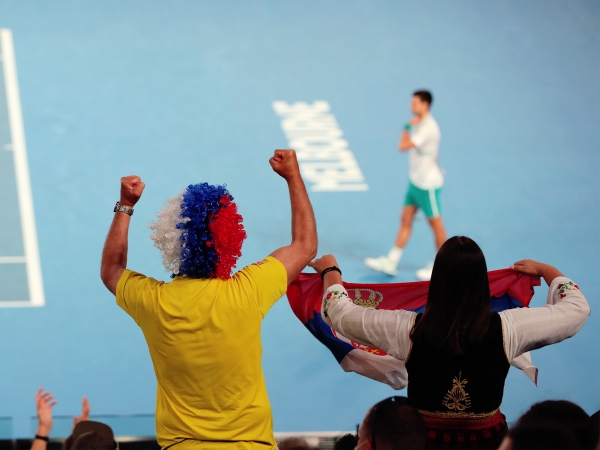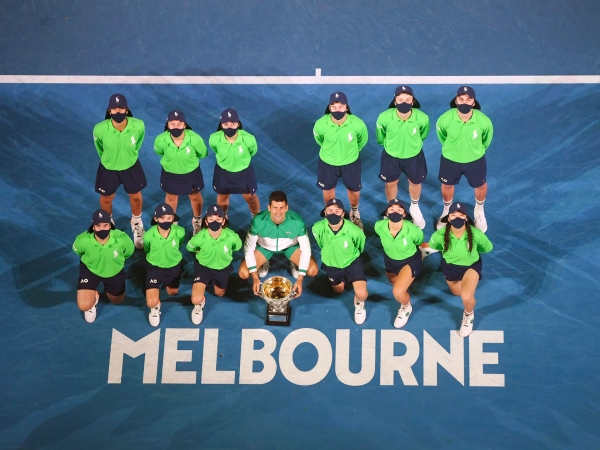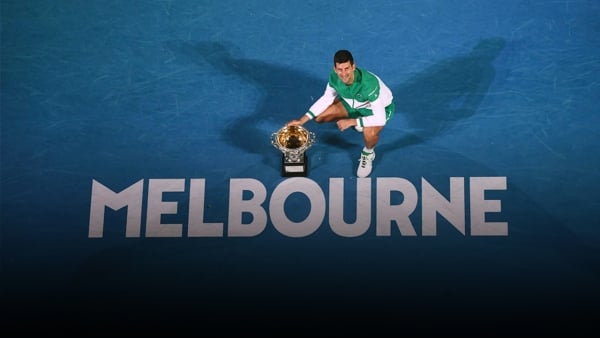Novak Djokovic hailed his opponent as the “man to beat,” but the world No.1 truly proved why he sits at the summit on Sunday night in Melbourne.
The Serbian lifted an unprecedented ninth Australian Open title, his 18th Grand Slam, with a clinical 7-5 6-2 6-2 triumph over Daniil Medvedev.
MORE: Ninth AO title for supreme Novak, Medvedev humbled
Here is how Djokovic created more history in his kingdom on Rod Laver Arena.
Key 1: Top serving from top seed
The defending champion had escaped a plethora of back-to-the-wall moments with 100 aces in his opening six matches.
It was apt the Serbian opened a dominant final with an ace too.
MORE: Djokovic sticks to familiar Melbourne script
Djokovic landed 67 per cent of first serves, winning 73 per cent on the first delivery, even sprinkling in a few delicate serve and volley points.
Never fully pushed to the limit, he was only broken twice by a player on a 20-match hot streak.
Key 2: Djokovic's rocket returns
Medvedev would have expected searing returns but they were razor sharp.
The Serbian broke instantly to set the tone, consistently finding depth.
The world No.1 was deploying his favoured tactic of cracking a return down the middle, giving the opponent no angle to play with.
MORE: Medvedev's reality check
Down 0-1 in the second set, Djokovic’s pinpoint returns helped rattle through four successive games, stealing away the initiative in the pivotal section of the contest.
Hitting 70 percent of returns in tested Medvedev’s composure and simply pinned the Russian behind the baseline on a majority of points.
The missile returns were so exemplary that Medvedev only won 9 of 32 points from second serve deliveries, constantly on the backfoot.

Key 3: Slicing and dicing
Medvedev had been on such a scintillating run coming into the final, Djokovic knew he had to disrupt the world No.4’s rhythm.
Deft backhand drop shots and knifed angled slices (also off the backhand wing) forced the Russian forward to play a tricky mid-court ball on numerous occasions.
Djokovic was then in command. He could choose to sit back and see what the Russian produced, or canvass the net (16/18 success rate) to pick off the ball.

Key 4: Long rally supremacy
In every department Djokovic held the upper hand.
The previous seven encounters (4-3 Djokovic) had been dotted with laser-beam, lung-bursting rallies.
This was no different and with his dogged determination, the top seed was at his defiant best, outlasting the 25-year-old in terms of patience and precision. 52:43 in rallies with 0-4 shots, 20:12 in points of 5-8 strikes and then 15:13 in rallies including 9+ shots.
Tactically, physically and mentally it was a masterclass.

Key 5: Major performer delivers on major stage
Medvedev was competing in his second Grand Slam final, whereas the reigning champion was going for glory in his 28th.
The start of the third set encapsulated this gulf in experience, Djokovic an expert in pacing himself in finals.
The Russian went for broke, earning two break points with flashy forehands. Medvedev would have the resources to last five sets and Djokovic knew it.
In response, the 33-year-old entered ‘no miss mode.’ He saved two break points and whilst Medvedev’s composure unraveled, Djokovic’s game built to a crescendo.
Down 2-4, Medvedev sparked a fierce forehand down the line, cajoling the crowd to get involved, to get behind him. Dismissed in seconds, Djokovic wasn’t in the mood for a comeback.
Having held for 5-2, Djokovic tapped his temple several times, demanding focus from himself.
Remember that Medvedev turned up on Rod Laver Arena with a 20 match winning streak, including 12 against Top 10.
Djokovic simply smothered him, reminding the tennis world of who sits on top.
